
Over $75 million in verdicts and settlements in 18 years.
Oregon Truck Underride Accident Attorney
Underride Truck Accidents
Truck Side Guard / Rear Guards
Manditory truck-trailer side guards and rear guard would be lifesaving for motorists, car passengers, cyclists, motorcyclists and pedestrians.
Large semi-trucks, dump trucks, and commercial vehicles present hidden dangers, especially in city traffic to the most vulnerable of roadway users: pedestrians, bikes and motorcycles. Trucks are also a unique danger to all motor vehicles on the road and their occupants.
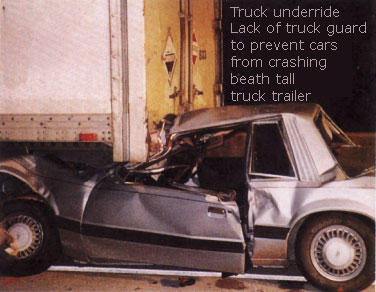
Trucks are especially dangerous to pedestrians, bicyclists, and motorcycle riders when turning right because large trucks leave huge blind spots for the driver.
Without sideguards, when pedestrians, cyclists, and motorcyclists get hit they are vulnerable to experiencing a worse secondary problem if they end up under the big truck.
Cars too can end up in bad situations without side guards to protect the driver and car passengers, and especially smaller cars are similarly often in these blind spots around the big trucks and trailers. The dangers to the most vulnerable road users are especially high in city streets.
Pictured Below: truck side guard rail [thank you Lloyd Alter / CC BY 2.0]
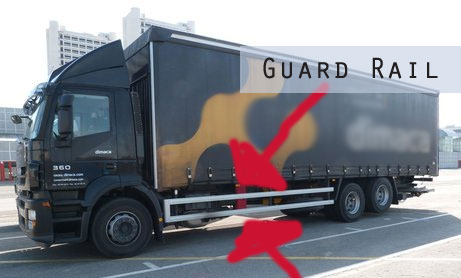
The Department of Transportation (DOT) has long been researching safety improvements and the dangers of rear and side big truck accidents and improving safety standards are still lagging. Many big trucks on the roads may appear to have a rear guard but not all these guards are built to withstand the same force, and some are more decoration than a rearguard capable to help prevent a passenger car severe consequences of an underride accident at highway speeds. Except for in some cities, like Portland, most big trucks and semi trailer rigs do not have the side guards. Yet the National Transportation Safety Board (NTSB) issued safety recommendations aimed at improving truck accident safety and saving lives since 2014, yet still nothing meaningful has happened:In its 2019 report, the GAO found that deaths from underride crashes represented less than 1% of total traffic fatalities from 2008 through 2017. But the agency also concluded that these fatalities are likely underreported [...] many states don't have a category in their crash reports to indicate if an underride crash occurred and that NHTSA's databases can sometimes contradict each other. [...] The GAO report's findings are in line with what personal injury lawyers and advocates have been saying for years: that underride crashes happen more than the data suggests.
FRONTLINE 2023: What Is An Underride Crash And Why Is It So Dangerous?
... is an independent federal agency charged by Congress with investigating every civil aviation accident in the United States and significant events in other modes of transportation—railroad, transit, highway, marine, pipeline, and commercial space.
We determine the probable cause of the accidents we investigate and issue safety recommendations aimed at preventing future accidents. In addition, we conduct transportation safety research studies and offer information and other assistance to family members and survivors for any accident investigated by the agency.
In 2014 the NTSB issued recommendations to corect safety vulnerabilities with tractor trailors, and they also had similar recommendations for big trucks like dump trucks and city garbage trucks.
Like large single-unit trucks, tractor-trailers may have blind spots that can reduce the ability of drivers to see other vehicles and road users. Researchers found that limited field of view can increase the risk of death or injury among passenger vehicle occupants, pedestrians, bicyclists, and motorcyclists when drivers of tractor-trailers change lanes, make turns, go straight, or back up.
Collisions with the sides of tractor-trailers resulted in about 500 deaths each year and that many of these deaths involved side underride. Researchers also found that current trailer rear underride guard standards are outdated. The recommendations call on NHTSA to require that both newly manufactured truck-tractors and trailers be equipped with side underride protection systems, and that revisions be made to improve trailer rear underride guard standards to better protect passenger vehicle occupants from fatalities and serious injuries [...]
NTSB Issues Recommendations to Correct Safety Vulnerabilities Involving Tractor-Trailers 4/3/2014
In 2016 the Department of Transportation Volpe Center had their own published safety standard recommendations released for side guards. In 2018 the Volpe Center continued to monitor the side guards on our roads.
Truck lateral protective devices are vehicle-based safety devices designed to keep pedestrians, bicyclists, and motorcyclists from being run over by a large truck's rear wheels in a side-impact collision.
The U.S. DOT Volpe Center is monitoring this technology's adoption in the United States, and has conducted research and partnered with public- and private-sector fleets to help deploy lateral protective devices and other technologies that address the deadliest road crashes: those between large trucks and pedestrians or bicyclists.
While large trucks comprise 4 percent of registered vehicles, large trucks are involved in 10 percent of pedestrian and bicyclist fatalities. In 2018, these nonmotorist fatalities rose to 541, the highest since 1990.
Despite Department of Transportation (DOT) researchers suggesting improvements to better protect motorists, passengers, bicylists, pedestrians, and motorcyclists, trucking industry influence and power seem to be more important than lives. The Vision Zero zero deaths Safe System principle requires safe vehicles.
The zero deaths vision acknowledges that even one death on our transportation system is unacceptable and focuses on safe mobility for all road users. This idea was first adopted in Sweden in 1997 as "Vision Zero" and since then has spread around the world.
Making a commitment to zero traffic deaths means addressing all aspects of safety through the following five Safe System elements that, together, create a holistic approach with layers of protection for road users: safe road users, safe vehicles, safe speeds, safe roads, and post-crash care.
Yet, it seems that the trucking lobby has more influence than Vision Zero protecting human lives on our highways. As they say this is Zero Vision, not Vision Zero.
DOT Researchers Suggested a Way to Make Big Trucks Safer. After Meeting With Lobbyists, Agency Officials Rejected the Idea.
On June 13, ProPublica and FRONTLINE detailed the industry's fight against a different, heavier side guard — one designed to prevent cars and other passenger vehicles from getting wedged beneath large commercial trucks during roadway collisions. Federal regulators have been aware of these deadly incidents, called underride crashes, for decades but have taken few measures to stop them.
In a statement, the DOT said its officials had thoroughly reviewed the researchers' report on the lighter side guards for pedestrians and cyclists, which are also known as lateral protective devices.
“America’s Dangerous Trucks” is part of a collaborative investigation from FRONTLINE and ProPublica.
Fortunately, the Department of Transportation opened a period for responses to their decision on rear guardand side guards. Hopefully safety improvements and the idea of Vision Zero will win eventually because of public outcry and the rising number of cyclists and ebike riders and multimodal pedestrians, but the delay will certainly mean more lives. Thankfully quality journalism has followed this story closely and timely release of the PBS / Frontline Documentary, America's Dangerous Trucks - underride accident focus in June 13, 2023.
Deadly traffic accidents involving large trucks have surged over the past decade. FRONTLINE and ProPublica examine one gruesome kind of truck accident — underride crashes — and why they keep happening. Trucking industry representatives and the government's lead agency on traffic safety have said that their top priority is safety. Drawing on more than a year of reporting — including leaked documents and interviews with former government insiders, trucking industry representatives, and families of underride crash victims — the documentary reveals how, for decades, federal regulators proposed new rules to try to prevent underride crashes. Over and over, pushback from trucking industry lobbyists won the day, leaving drivers of smaller vehicles vulnerable.
New York City, Boston and Portland, Oregon have installed on their own city fleets, improved side guards and rear guards, because these help save bicycle and pedestrian lives. And, Portland, Boston and New York City made this progressive life saving change after catastrophic and unnecessary roadway fatalities of cyclists, pedestrians, and motorcyclists, often by big trucks and semi's turning right.
In New York City trucks are only 3.6 percent of vehicles on the road, but collisions with trucks account for 12.3 percent of pedestrian fatalities and 32 percent of bicyclist fatalities. [...]
In the United Kingdom, widespread adoption of side guards is credited with reducing fatalities and severe injuries in side impacts by 61 percent for bicyclists and 20 percent for pedestrians. [...]
City Begins Installing Truck Sideguards To Protect Pedestrians And Cyclists February 9, 2015
The city of Portland has committed to the Vision Zero Pledge and now requires truck Side Guards to be fully implemented by 2023. PNW company Walker Blocker has already retrofitted the entire City Fleet for Portland. From the Water Bureau to Forest to City, Walker Blocker has retrofitted all of them. All class 3 and above trucks, including Garbage trucks.
While a big step in the right direction, in NYC it is only 240 vehicles of the city's fleet to be fitted with side guards, private trucks are not required to have this safety feature, and that is over 27,000 of NYC municipal fleet and an identified 4734 trucks appropriate for side guards, but only 240 of the elgible city fleet getting the installation.
In Boston the ordinance madated all large city contracted vehicles to be equipped with enhanced safety measures to reduce the risks of a collision with pedestrians and cyclists.
Boston EMS responded to over 750 pedestrian traffic incidents in 2013. Since 2010, 11 cyclists in Boston have died as a result of crashes with motor vehicles, and seven of those fatal incidents occurred between a cyclist and either a truck or a bus. [...] Convex blind spot mirrors and cross-over mirrors, similar to those found on a school bus, will allow drivers of large trucks to see the areas in-front of, and to the sides better, preventing "right hook" incidents with cyclists.
City Council Passes Truck Side Guard Ordinance First in the nation, will increase safety measures to protect cyclists October 29, 2014
Underride guards on both sides and rear seem to make obvious sense. While the cities stepping forward first is admirable, it's a small step in the right direction.
Side Guards
Large truck side impacts comprised 15 percent of fatal two - vehicle collisions between large trucks and passenger vehicles during 2011. Furthermore, research indicated that passenger vehicle collisions with the sides of tractor - trailers resulted in more than 15,000 injured persons during 2001 - 2003.
In 2012, Brumbelow estimated that 530 passenger vehicle occupants died each year during 2006 – 2008 in two - vehicle collisions between passenger vehicles and the sides of large trucks.
NTSB Safety Recommendations April 2014
Rear Underride Guards
Truck rear impacts. Rear impacts to tractor - trailers are common: according to the GES, there were 15,329 police - reported collisions in which passenger vehicles collided with the rears of tractor - trailers during 2005 – 2009 (about 3,065 annually). NHTSA reported that large truck rear impacts comprised 19 percent of fatal two - vehicle collisions between large trucks and passenger vehicles during 2011.
NTSB Safety Recommendations April 2014
Truck Driver Blind Spot / Visibility
Trucks are incredibly dangerous on the road. Side Guards are a huge safety improvement, but the problem of blind spots and poor visibility is a major reality and problem that must be addressed if we are to take Vision Zero goals seriously, that is to end traffic deaths.
The blind spot on the right side of the tractor - trailer is of particular concern because it impinges on a large portion of the driver's field of view and is disproportionately involved in collisions involving pedestrians, cyclists, and passenger vehicles. [...] death rates of vulnerable road users involved in collisions with tractor - trailers were high: 152.8 per 1,000 involved pedestrians/cyclists and 119.5 per 1,000 involved motorcyclists. In comparison, death rates were 2.0 per 1,000 involved tractor - trailer occupants and 10.9 per 1,000 involved passenger vehicle occupants.
NTSB Safety Recommendations April 2014
The image below illustrates the truck driver blind spot with the shade area. Note that the motorcycle rider is essentially not seen by the truck driver because of the truck cab obstructing a view even though both are situated in traffic.
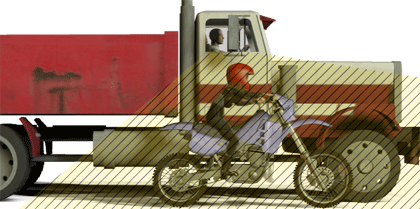
This is the same scene with a motorcycle rider next to the truck cab and the line of site that the truck driver could see out the truck cab window, showing just the tip top of the helmet possible to view.
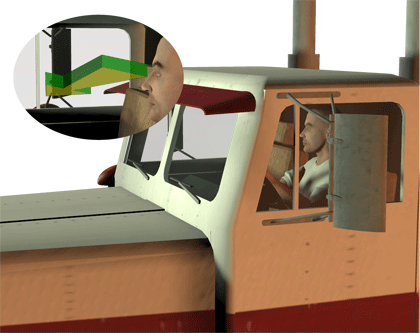
The same problem with an average height person being shorter than the truck cab window height.
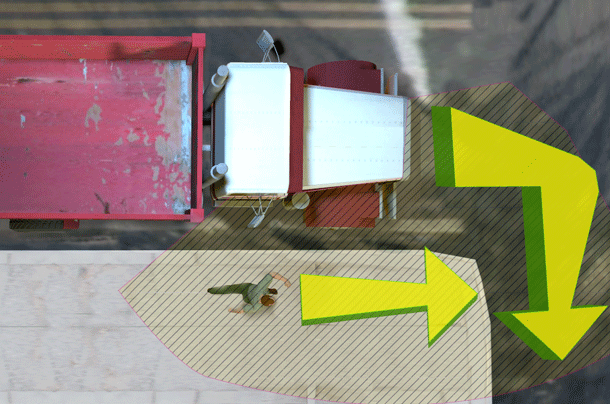
Other Big Safety Improvements / Vision Zero
Technology may come through with some big new things like proximity detection systems with audible warnings for the truck driver as well as those sharing the road. Cameras into blind spots to help the truck driver see behind, and through the blind spots. One idea is that when the truck driver turns on a turn signal, the proximity detection system automatically gives warning if the lane or area is not clear, breaking and avoidance systems might also be triggered.
In Europe there is talk of requiring retro-fit of the truck mirrors and the doors in the cab to make the truck cab doors glass that can be seen through the blind spots. There are also ideas for new truck cab designs.
Some safety advocates would like to see a range of reforms: training for drivers, restrictions on the size of trucks allowed on busy city streets, better designed streets that will give pedestrians and cyclists more protection, tougher penalties on drivers who kill bicycle riders and pedestrians, blind spot mitigation, side underride protection systems, rear underride protection systems, and of course improve crash data reporting.
There's a massive problem with the state and federal crash data reporting which means we don't even have all the data in the information age which could inform us more precisely about which truck trailers are dangerous, which truck cabs involved with particular types of pedestrian or small vehicle accidents. Huge safety improvements are within reach.